Due to their combination of utility, fuel-economy, and price, compact crossovers have been the hottest market segment in recent years. Nearly every make now offers one. Mercedes-Benz introduced the GLK350 as an early 2010 model and has updated it for 2013. In such a crowded, contentious field, why buy the one with the three-pointed star?

Chiseled Mercedes lines, 19-inch wheels, fancier headlights. more GLK-Class photos
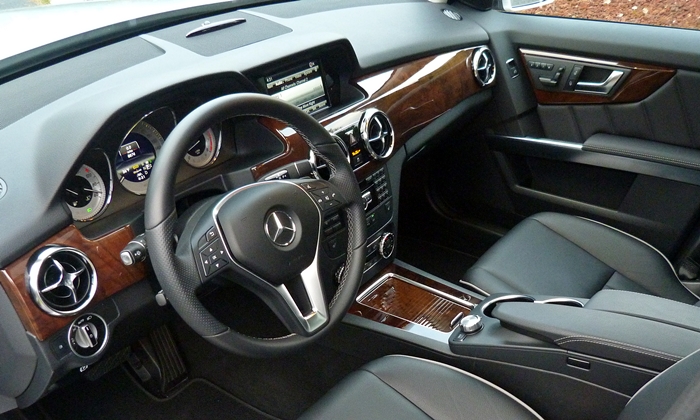
More wood, more chrome, more curves, better materials.
| |
Compared to the X3 |
| Brand reputation & image |
 Better
Worse
Better
Worse
|
I don't personally put much stock in brands, with cars or anything else. But each time I have a Mercedes-Benz for a week the continuing power of the marque has been unavoidable.
Audi and BMW now command similar prices, but haven't yet acquired the same mystique. They probably never will for people born before 1980. Until the final years of the twentieth century, Audis were largely ignored as troublesome, modestly upgraded VWs and BMW was mostly known for the compact, still semi-affordable 3-Series. Neither could hold a candle to the company that invented the mass-produced automobile and that has been strongly associated with large, top-shelf automobiles ever since.
Gayla (the site's programmer, my wife) is not a car person. Her take on the GLK: "Of course it's a good car, it's a Mercedes." Some of my friends who are more into cars--and who own competing makes--similarly employ a different tone when asking about "the Mercedes." They could afford one, so why don't they own one? Partly because the brand's mystique cuts both ways. They're not interested in making such a strong status statement.
Can even a compact crossover make a strong status statement? Mercedes-Benz has done its best to make this so--check out the size of the three-pointed star on the GLK's grille.
| Interior styling |
 Better
Worse
Better
Worse
|
Looking beyond the grille, the GLK's exterior has always appeared not quite premium to me. The truncated, very square rear end looks more Subaru than Mercedes. Yet I must grant that the GLK's exterior makes a stronger design statement than those of the Audi Q5 and BMW X3. For 2013 both ends of the GLK have gained fancier, LED-filled lamp assemblies.
But the most notable upgrades happened inside the GLK350. The original interior was overly plain and chock full of flat, hard black plastic. Even more than the exterior it didn't suit the brand. Back in 1970s and 1980s Mercedes had plain interiors compared to Cadillacs and Lincolns, but since at least 1990 premium car buyers have expected a premium interior. These buyers should find the 2013 GLK's interior, with more curves, more wood, more chrome trim, and upgraded materials, much more suitable. Now it's Audi's and BMW's turn for upgrades.
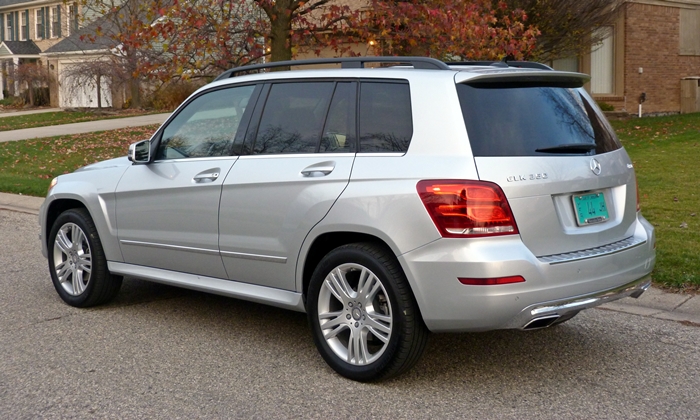
New LED tail light assemblies.
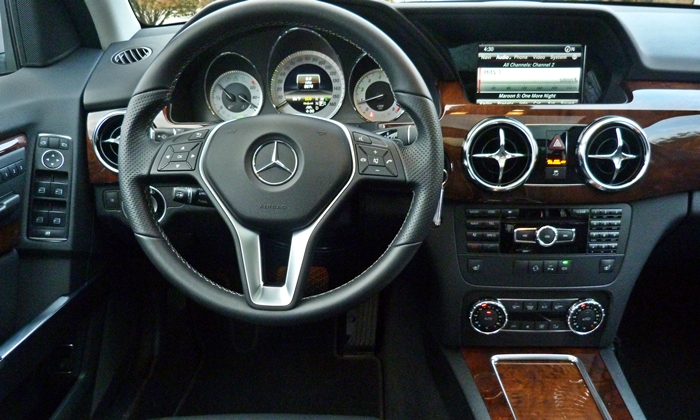
Note revised instruments, center stack, shiny round vents.
| Ride smoothness |
 Better
Worse
Better
Worse
|
Back when Mercedes lacked glitz, how did they gain and maintain a premium image? Partly by oozing solidity. The GLK350 carries on this part of the marque's tradition. The average car has gotten much more solid over the last two decades, with even Chevrolets and Fords now challenging upscale brands on this basis. But when pulling a door closed or driving down the road the GLK350 still feels at least a little more solid than the others.
While the GLK350's ride can't be characterized as plush, it is smooth, quiet, and steady. The ride quality of the BMW X3 improved quite a bit with a 2011 redesign, but it remains much more likely to jerk and jostle despite smaller standard wheels (17s vs. the 19s on the GLK350).
| Safety & braking |
 Better
Worse
Better
Worse
|
Mercedes-Benz's reputation was also built by often being first with innovations, especially those focused on safety.
Every updated Mercedes beginning with the 2010 E-Class has received a standard drowsiness monitor. The system evaluates the frequency and amplitude of steering corrections. Drive like a drowsy person, and a coffee cup icon will appear below the speedometer (in case you're not aware you're falling asleep).
Blind spot and lane departure warnings are available in passive and active forms. In "active," the system goes beyond a graphic between the tach and speedo to selectively blip the brakes and tug the wheel to help get the car back where it's supposed to be. I didn't care for this intervention. Touch the lane marker (quite easy to do on the blind side) and you'd think death was imminent from the strength of the system's reaction.
The optional adaptive cruise control works very well, even in traffic. On some trips around town I let the GLK do most of the driving. (The car, through its driving style evaluator, gave itself a grade of 46 percent.) Even when not turned on, the Distronic system will sound a warning if you approach the car ahead too quickly. If you don't react, the GLK will attempt to stop itself.
I could go on and on in this area, the GLK includes so many safety features. But I'm out of space.
| Driving position & visibility |
 Better
Worse
Better
Worse
|
Sitting high within a tidy package is what the compact crossover category is all about, and the GLK has this base covered. The windshield is more upright and more distant than most. This will count as a positive for some people, a negative for others. The quasi-Hummer view forward does contribute to a feeling of unstoppable solidity. The side and rear windows are tall by current standards, for good visibility in those directions as well.
| |
Compared to the X3 |
| Handling |
 Better
Worse
Better
Worse
|
Mercedes-Benz proclaims the GLK350 as the "SUV embodiment of a sport sedan's soul." The right boxes have been checked: big V6, nearly balanced weight distribution, 19-inch wheels, and (for 2013) paddle shifters for the transmission, all as standard equipment. The retuned suspension does manage body motions and lean better. The new, electric-assist steering provides no more feedback than the numb old hydraulic unit, but contains less slop. Drive the GLK350 casually, and it behaves well.
But push the baby Benz ute and the veneer of sportiness falls away. Instead, in hard turns you'll discover limited grip from the Michelin Latitude Tour HP tires as the nose plows towards the curb and a non-defeatable, far-from-transparent stability control system jerks your chain.
Premium compact crossover buyers looking for fun are much more likely to find it in the competing Audi, BMW, Infiniti, or Volvo.
| Rear seat room & comfort |
 Better
Worse
Better
Worse
|
Expect the GLK to grow when it is next fully redesigned. A smaller MLK is on the way to battle the upcoming Audi Q3 and just-arrived BMW X1. For 2013, the GLK's body structure remains essentially the same, so rear seat knee room remains just sufficient for a man of average height sitting behind another such man. (Headroom, on the other hand, is abundant.) Among competitors, only the Infiniti EX37 has a tighter rear seat. The Audi, BMW, and Volvo all offer knees another inch or three. Seat comfort is debatable. To my bottom, the GLK's seats feel overly firm.
Cargo space is similarly short of the segment average. The GLK's 54.7 cubic feet isn't far behind the Audi's 57.3 but well below the X3's 63.3. That truncated tail has a downside beyond aesthetics.
But do these shortcomings really matter? For most people nearly all of the time, there's enough space.

Big star.
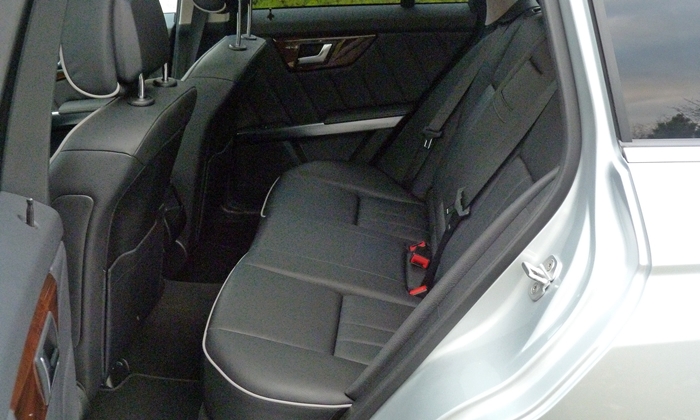
Adults can fit, but with little knee room to spare.
| Controls and instruments |
 Better
Worse
Better
Worse
|
No big issues here, just a few minor niggles. At dusk, the main instruments are difficult to read. The HVAC controls at the base of the center stack would be easier to use if they were angled upwards towards the driver's eyes, were located higher up, or both. The knob-based COMAND system isn't too difficult to use once you figure out its basic structure (primary menu along the top edge, secondary menu along the bottom edge, content in the middle), but often requires a lot of toggling.
On the plus side, the GLK's infotainment system can now connect you to news, Google search, Yelp, Facebook, and (when parked) the entire Internet for $14 a month on top of the $280/year basic mbrace telematics fee. Also, Mercedes has finally located the turn signal stalk above the cruise control stalk. Those not thoroughly familiar with Mercedes are much less likely to set the cruise when attempting to signal a turn.
| Fuel economy |
 Better
Worse
Better
Worse
|
If you prioritize performance, the GLK's mandatory 3.5-liter V6, upgraded via direct injection from 268 to 302 horsepower for 2013, might seem a good thing. But even after the power bump, the boosted sixes in the Audi and BMW are stronger, and they're paired with more responsive eight-speed automatics (vs. a seven-speed transmission introduced nearly a decade ago).
More of an issue for most potential buyers: fuel economy. The GLK350 is more efficient for 2013, thanks to direct injection, electric-steering assist, driving style feedback, and a shudder-free automatic start/stop system (study it, BMW). The EPA ratings have improved from last year's 16 mpg city, 21 highway to 19/24.
But even 19/24 is only marginally competitive in the 2013 challenge. The BMW X3 xDrive28i is nearly as quick, and rates 21/28. The quicker X3 xDrive35i matches the GLK in the city, but does a couple mpg better on the highway.
In our real-world suburban driving, the GLK350 trailed the BMW X3 xDrive28i by one to two mpg. Not a big difference, but a difference.
Mercedes will soon offer a more fuel-efficient engine option in North American GLKs. But it won't be a smaller gas engine. Instead, the new GLK250 will be motivated by a 190-horsepower, four-cylinder diesel engine.
| Price or payments |
 Better
Worse
Better
Worse
|
Load up a GLK350, and the price jumps from $39,995 to the tested car's $55,015. Even this price does not include proximity key ($650), premium audio ($810), an Appearance Package (20s, shiny roof rails), and an AMG Styling Package that includes the previous and adds more aggressively styled fascias and wheels ($1,990). A very well equipped, surprisingly good Ford Escape runs over $14,000 less even after a nearly $3,000 adjustment for the GLK's additional features.
And the Audi Q5 and BMW X3? This depends on whether you specify the turbo fours, which aren't quite as quick as the GLK350, or the boosted sixes, which are quicker. With four-cylinder engines, the BMW is about $1,200 less and the Audi is about $4,000 less. But if you're feeling the need for a six, the Q5 and especially the X3 are more expensive than the GLK. The X3 xDrive35i is $700 more before adjusting for feature differences, $3,700 more afterwards. The Audi Q5 3.0T is just a little more, but a decade ago the thought of an Audi that cost even a dime more than a comparable Mercedes would have been laughable.
Mercedes no longer stands head and shoulders above competitors. But the GLK's interior has received a much-needed upgrade, and solidity and safety features remain Mercedes strengths. Even with the tweaks for 2013 the GLK doesn't handle like a BMW. But many potential buyers will care no more about this than the crossover's limited space for rear seat passengers and cargo. The key question for those who can afford the GLK: can you see yourself wearing a big three-pointed star? (Gayla can.)
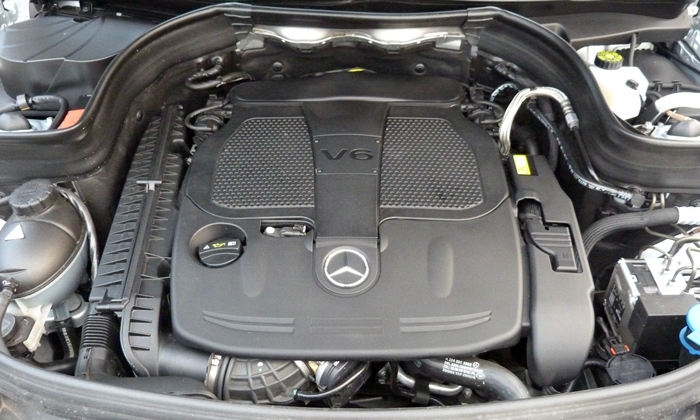
Direct injection bumps horsepower from 268 to 302.
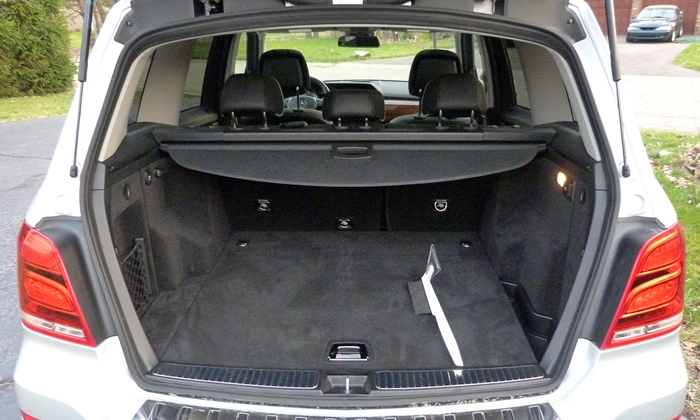
Less cargo room than most compact crossovers, but more than enough 99 percent of the time.
See more 2013 Mercedes-Benz GLK-Class photos
Mercedes-Benz provided an insured car with a tank of gas.











